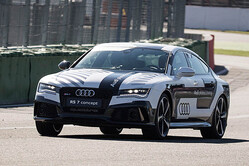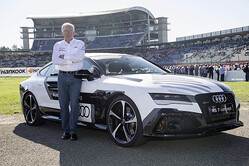


22/10/2014
NEWS STORY
 At the DTM season finale at Hockenheim at the weekend, an Audi RS 7 completed a lap of the GP track... at racing speed, without a driver.
At the DTM season finale at Hockenheim at the weekend, an Audi RS 7 completed a lap of the GP track... at racing speed, without a driver.
It took the RS 7 slightly over two minutes to complete a lap on the Hockenheim track, the car "piloted with high precision and accuracy to within centimetres" according to the manufacturer.
"The performance by the Audi RS 7 today substantiates the skills of our development team with regard to piloted driving at Audi," said Prof. Dr. Ulrich Hackenberg, Board Member for Technical Development at Audi AG. "The derivations from series production, particularly in terms of precision and performance, are of great value for our further development steps."
For orientation on the track, the technology pioneer uses specially corrected GPS signals. This GPS data is transmitted to the vehicle via Wi-Fi according to the automotive standard and redundantly via high-frequency radio. In parallel to this, 3D cameras in the car film the track, and a computer program compares the cameras' image information against a data set stored on board. This is what makes it possible for the technology pioneer to orient itself on the track within centimetres.
 Piloted driving is one of the most important development fields at Audi, the first successful developments being achieved ten years ago. The test results continually flow into series development. The latest test runs at the physical limit are providing the Audi engineers with insights for the development of automatic avoidance functions in critical driving situations, for example.
Piloted driving is one of the most important development fields at Audi, the first successful developments being achieved ten years ago. The test results continually flow into series development. The latest test runs at the physical limit are providing the Audi engineers with insights for the development of automatic avoidance functions in critical driving situations, for example.
Driver assistance systems from Audi are already making (road) driving more relaxed and better controlled, and can be experienced in the updated A6 and A7 Sportback series.
Experts from Volkswagen Group Research, the Electronics Research Laboratory (ERL) and Stanford University (both in California) are supporting Audi as partners in the further development of piloted systems.
Audi is claiming an average speed for the lap of 149 mph, thereby setting a driverless car record, while a subsequent lap in which a the 560 bhp car was driven by a human was around five-seconds slower.
{youtube eOYsI1cqUrw 560x315}